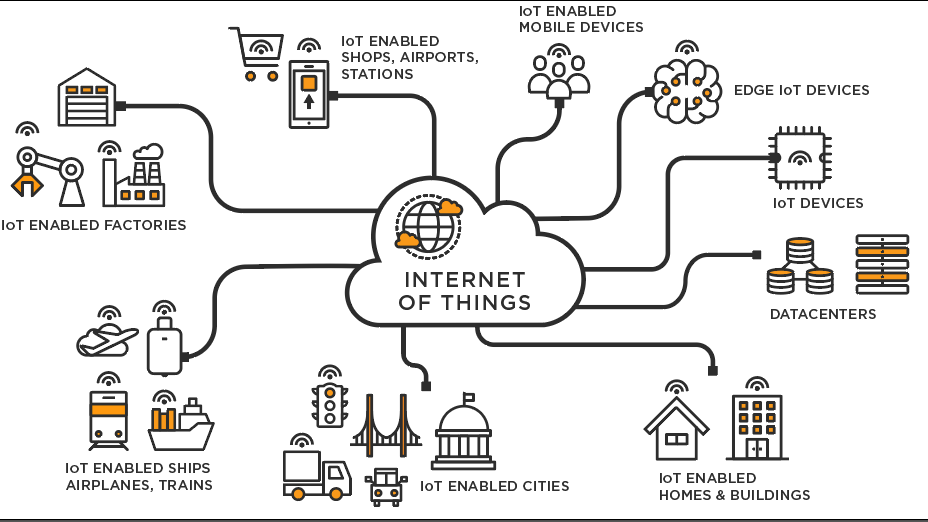- Home
- Prelims
- Mains
- Current Affairs
- Study Materials
- Test Series
 EDITORIALS & ARTICLES
EDITORIALS & ARTICLES
What Is the Internet of Things (IoT)?
Internet of things (IoT) broadly means “All objects, which are connected to the web, will be enabled to share and process data through their sensors and communication devices independently”. It is estimated that by 2023, globally there may be 7 billion connected people, more than 30 million applications and embedded systems, more than 60 trillion GBs of data and around 8 trillion revenue opportunities. The IoT market value is expected to reach $11 trillion with security spending reaching $3.5 billion shortly.
The history of IoT evolution started with archaic mode of interaction between human and thing (people and things), followed by interaction of machine and machine (things and things), leading to interaction of people kicking off through proverbial internet (people and people), resulting in multiple things getting connected on net (web of things) and then finally the internet of humanity.
IoT in agriculture basically involves the network wherein physical components in the sector are to be connected with the internet which may be the farms comprising trees, plants, and animals, the tools and various objects in the sector. This enables information exchange, monitoring and tracking, helping humans manage complex agricultural sectors more productively under certain protocols. For example, most of the developed countries such as Germany, Japan and US has already moved ahead in sensor technology and manufacturing processes. The net benefit of IoT application is the increased agricultural output, improved quality of agricultural products, reduced labour costs coupled with increased agricultural income for farmers.
Intelligent agricultural machinery or IoT incorporates cluster IoT, remote IoT and internal IoT. While cluster IoT focuses on communication and control between agricultural machinery operating in the same area, remote IoT is between operation sites and remote terminals and servers. The communication between sensors, actuators and the central processing unit in agricultural machinery is referred to as Internal IoT.
IoT finds immense application in the agricultural sector, wherein, the sustainable future of food is considered as the target by almost all the developing economies. By 2050, it is expected that the world population will grow by 30% to 10 billion and this requires increase in agricultural productivity by 1.5 times. The global climate stability target involves inter alia at least 67% curtailing of greenhouse gas emission which necessitates rectifying problems with the current system. In developing Countries, there are multiplicities of problems in the agricultural sector such as lack of a system for crop selection, faulty irrigation system, no integration with weather forecasting, no process for soil testing, inefficient animal husbandry etc.
In view of the above, monitoring of climate conditions and efficient decision making should necessarily be part of the sustainable agricultural strategy. Precision in agricultural decision making with the help of data i.e., tons of data, collected by smart agriculture sensors help the agricultural scientists to devise suitable strategies to address the challenges. This may result in better control over the internal processes and, as a result, lower production risks. Application of IoT may also contribute to greenhouse automation wherein weather stations automatically adjust the conditions to match the given parameters and smart sprinklers controller allows managing irrigation and lighting systems remotely.
Globally, in light of the water scarcity having significant impact on agricultural production, application of IoT enables choosing appropriate irrigation methods instead of traditional flood irrigation method, solving the problem of water shortage to a great extent. IoT also finds application in cattle monitoring and management wherein IoT devices are attached to the animals on a farm to monitor their health and log performance. The collar tags attached to the species (comprising wireless link, actuators, sensors, and terminal equipment) helps to deliver temperature, health, activity, and nutrition insights on each individual cow as well as collective information about the herd. This enables farmers to analyze nutritional and physiological status of animals and ensure their healthy growth.
Crop management is another key area, where IoT finds application, especially in collecting data specific to crop farming; temperature and precipitation to leaf water potential and overall crop health. This may help inter alia monitor crop growth and any anomalies to effectively prevent any diseases or infections that can harm the proposed yield. Soil testing is another area of application wherein efficient planning may help strategically coordinate crop cycle and irrigation which may lead to efficiency improvement in the areas of power usage and fertiliser cycle.
Agricultural product quality, safety and traceability is another benefit of IoT wherein agricultural product warehousing, logistics, and distribution comes into picture. Through high speed internet connectivity coupled with application of electronic data exchange, electronic tags and barcodes; the agricultural inputs and outputs could be traced, used and stored legitimately, thereby reducing wastage, resulting in enhanced efficiency in the system.
Advanced research in the area of IoT system structure is still in progress due to which there may be reduction in the timeliness of data transmission by IoT due to issues such as data transmission instability coupled with data sharing difficulties, poor positioning accuracy etc. Data speed is another requirement for IoT enabled systems which is indeed lacking in almost all the developing economies where farming activity mostly occurs in remote rural areas. The investment required for 5G and related technologies, a key enabler for agricultural IoT, is also very high and facilitating the same in rural areas is indeed a challenge.
Barring these few challenges, end-to-end farm management systems should necessarily be part of IoT strategy in the upcoming technology era. A powerful dashboard with analytical capabilities and in-built accounting/reporting features enables farmers to improve efficiency by continuous monitoring, efficient coordination, and automated low-level decision making. Thus, it is time to focus on facilitating increased investment in the agricultural sector, through public private partnership led by Government investing in key areas to derive the desired long term benefits to the economy.










 Latest News
Latest News General Studies
General Studies